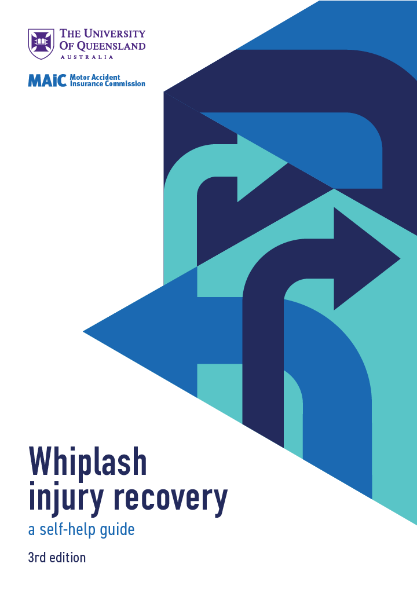Whiplash consumer resources
My Whiplash Navigator: Guided Whiplash recovery
 My Whiplash Navigator is a self-directed program to guide people on how best to recover after a whiplash injury. Healthcare professionals can access up-to-date information on assessment for whiplash (what and how to assess) and optimal management.
My Whiplash Navigator is a self-directed program to guide people on how best to recover after a whiplash injury. Healthcare professionals can access up-to-date information on assessment for whiplash (what and how to assess) and optimal management.
Whiplash treatment options resource
RECOVER researchers have developed a Whiplash Treatment Options resource. The resource is designed to assist you in your discussions with your healthcare provider about the treatment of whiplash.
Whiplash injury recovery: a self help guide
 This booklet aims to help people who have a whiplash injury on the road to recovery. It provides information about whiplash associated disorders, an explanation of whiplash, an exercise program which has been proven to assist in reducing neck pain and advice on how to manage your neck to prevent unnecessary strain and to aid recovery. Download the guide (PDF, 1.06MB)
This booklet aims to help people who have a whiplash injury on the road to recovery. It provides information about whiplash associated disorders, an explanation of whiplash, an exercise program which has been proven to assist in reducing neck pain and advice on how to manage your neck to prevent unnecessary strain and to aid recovery. Download the guide (PDF, 1.06MB)
Videos on how to perform the exercises in the booklet can be found on the Motor Accident Insurance Commission website.
What is Whiplash?
Whiplash is a common term for sudden acceleration-deceleration forces on the neck as a result of rear-end or side impact motor vehicle collisions, diving accidents and/or other mishaps.
These forces may result in bony or soft tissue injuries such as discs, ligaments, tendons, neck muscles, and nerve roots.
Other terms:
- neck strain
- acceleration flexion-extension neck injury
- soft tissue cervical hyperextension injury
What is Whiplash Associated Disorder (WAD)?
WAD is a term used to describe a range of symptoms resulting from whiplash. These can vary from no symptoms to severe.
WAD injuries are usually graded on a severity scale between 0 and 4.
| Grade 0 | No pain or discomfort. No physical signs of injury. |
|---|---|
| Grade 1 | Neck pain, stiffness or tenderness. No physical signs of injury. |
| Grade 2 | Neck pain, stiffness or tenderness and some physical signs of injury such as point tenderness or trouble turning the head. |
| Grade 3 | Pain, stiffness or tenderness and neurological signs of injury, such as changes to reflexes or weakness in the arms. |
| Grade 4 | Pain and fracture or dislocation of the neck. |
Whiplash symptoms
The most common symptom after a whiplash injury is neck pain or stiffness. This can occur immediately after the injury or even after a few days.
Other symptoms may include:
- headaches
- pain in the shoulders and arms
- dizziness
- altered sensation such as pins and needles or numbness
- weakness
- visual and auditory symptoms
- dysphagia
- concentration difficulties
